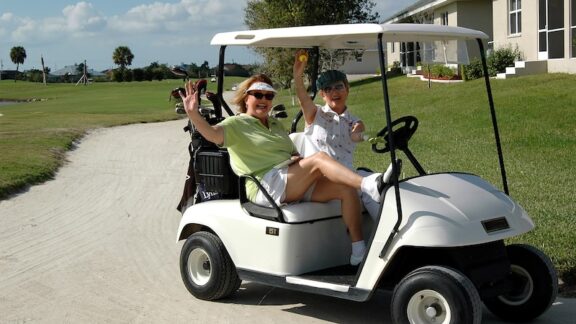Autumn provides the ideal opportunity for nature therapy, from neighborhood strolls to spending a night under the stars. Cooler temperatures mean amazing sleeping weather, fewer pesky bugs, smaller crowds at campgrounds, and cozy campfires. And then there’s the amazing technicolor leaf show! Even if it’s been a while since you’ve camped, these 12 tent camping tips for seniors can make your outing naturally therapeutic.
1. Planning and preparation are essential!
If you’ve never been a list maker, now is the time to start! You won’t want to get to a campground and find you’re missing essentials. Start by listing items you’ll need, then noting which ones you have and which you need to purchase or borrow.
Camping gear can range from modest to exorbitant, primitive to almost luxurious. Your choices depend upon your budget and comfort preferences. If you’re not sure this will be a long-term love, borrow a tent and camping gear.
In addition to making checklists and gathering all your gear in advance, be sure to put up your tent at least once before your outing. Not only will you be more confident, you’ll be sure that nothing is missing. I’ll never forget the first camping trip after I’d loaned my tent to a friend who returned it … without the poles!
Before you leave, let someone know where you’re going and how long you plan on being gone. And plan on doing the same if you set out on a hike.
2. Find your best sleeping quarters.
If you remember the old days of struggling to set up a tent, you’ll be thrilled with contemporary “instant tents”! Newer design and materials create tents that are lightweight and oh-so-easy to erect and break down.
- Get a large tent, such as a 4- to 6-person tent, even if just for one or two people. A roomier, taller tent will give you room to stand (mostly) – your back will thank you – and to keep gear close at hand.
- Choose material that’s sturdy yet breathable, with screened windows for airflow.
- Be sure to use a rain fly, which deflects both rain and dew.
3. Take comfortable seating.
A campground with picnic tables provides seating that is useful … but not comfortable! Tote along a camp chair for relaxing in comfort.
4. Simplify food preparation.
Unless you’re a gourmet cook who loves every step of food preparation and clean-up, remember one important tip: SIMPLIFY! This means:
- Focus on foods that don’t require refrigeration, like bread, peanut butter, honey, individual cans of tuna, fruit, vegetables, etc. If you want to grill meat or poultry, eat it on the first evening.
- Having reusable dishes, utensils, and napkins is ideal, but disposable ones can simplify the experience for beginners. If you go the disposable route, choose earth-friendly options such as those that are corn-based or made from previously recycled materials.
- Remember to pack cooking utensils. Camp stores don’t always carry items such as spatulas, and you can’t flip pancakes without one. (That’s a lesson I learned firsthand!)
- Take versatile cookware that serves a diversity of purposes. My favorite piece of camping kitchen equipment was an electrical skillet, for eggs, bacon, pancakes (using Bisquick Shake ’n Pour), grilled cheese sandwiches, one-pot meals; etc.
- Be sure to bring eco-friendly dish detergent, dish rags, and a dish pan for clean-up.
5. Prepare for a good night’s sleep.
Fresh air and exercise provide natural sleep aids. However, if you’re uncomfortable, sleep can be evasive.
- Use a cot, sleeping pad, or air mattress, both for insulation and padded comfort. I don’t know about you, but I’ve become like the princess who could detect the pea under a stack of mattresses!
- Take a sleeping bag appropriate for the temperature. The ratings aren’t as straightforward as they may seem, so if the nighttime temperature may go below your comfort level, be sure to use a reputable sleeping bag temperature ratings guide.
- Pack a sheet and blanket for lightweight cover, as well as pillows.
- Although a totally flat surface is ideal for sleeping, if your tent is on an incline, be sure to orient your feet lower than your head.
6. Light up the night – but not too much!
The best camping lights provide enough illumination for safety and convenience without dispelling the darkness entirely. Not only do bright lights interfere with appreciation of nighttime wonders, but they also interfere with the natural cycles of wild critters, from insects to birds to mammals. In that spirit:
- To illuminate the campsite, use a lantern with adjustable brightness, like the Black Diamond Remoji Lantern. Ideally, it will stand and hang, for use on a table and in a tent.
- For navigating around the campgrounds, use knuckle lights rather than a flashlight. These where-have-you-been-all-my-life lights slip comfortably over your fingers, perfect for toting a dog leash, toiletry bag, firewood, or anything else. (You’ll appreciate them once you get home, too!)
- If stargazing is on your itinerary, use a light source that includes a red light, which illuminates with less night-vision interference, such as the Petzl Tikka outdoor headlamp.
7. Pack appropriate clothing.
While fall provides optimal conditions for enjoying the outdoors, you’ll also have to plan for erratic temperatures. To be sure you’re comfortable:
- Pack layers, from insulated underwear to warm top layers, which you can remove as needed. Ideally, the layers closest to your skin will be of a material that wicks moisture to keep you from getting chilled. Warm, wicking clothing can supplement the warmth in your sleeping bag, too.
- Reuse pants, shirts, etc., but always have a backup in case you get wet. Also pack extra underwear and socks.
- Include gloves/mittens, hat, scarf, and rain jacket.
8. Plan for plenty of enjoyable activities.
Besides nearby outdoor fun, like hiking, kayaking, cycling, fishing, etc., consider downtime and inclement weather. Tote along a book, magazine, or tablet; a sketchpad or journal, etc. Cards and other games are great for couples and groups. But allow yourself plenty of nothing time, too, to absorb the sounds, smells, and sights of the outdoors!
9. Plan for other specific and essential needs – especially important in tent camping tips for seniors.
Consider travel items that are especially essential for older adults:
- Mobile phone charger
- Medications (and a way to keep them cold, if needed)
- Copies of your prescription
- First aid kit
- Foods and snacks and drinks to maintain dietary requirements
- Sunscreen, insect repellant, sunglasses, and spare glasses
- Coffee or another source of caffeine
- Dog supplies, including bowls, food, leash, stake and tether, etc.
- Filled water cooler
10. Pick a perfect location.
From nearby state parks to our nation’s amazing national parks to private campgrounds, you’re sure to find a beautiful canopy for pitching a tent.
- State parks are often well-equipped to entertain guests with relatively inexpensive prices and useful amenities.
- America’s national parks showcase the country’s most beautiful nature, from seashore to mountains to rugged landscapes. Many offer camping opportunities, too. Better yet, the annual Seniors Pass is only $20 for any U.S. citizen or permanent resident age 62 or older.
- Private campgrounds such as KOA and Jellystone typically offer more extras such as camp stores and recreation.
- 55+ campgrounds offer peace and quiet for senior camping trips, since not everyone’s kids are as adorable and winsome as your own or your grandkids. They also typically have plenty of conveniences and amenities.
As you’re choosing your destination, look for
- Campground extras such as a camp store, toilets and showers, picnic tables, after-hours check-in, and on-site hosts to provide assistance when needed.
- A small town nearby, for supplies you may have forgotten, conveniences, or a hotel if you decide to throw in the towel!
- Always check before leaving for changes due to COVID-19, weather, or other incidentals.
- Get to the campground early enough to erect the tent right away and in the daylight.
- Avoid temperature extremes, and remember that temperatures drop as elevation increases.
11. Choose a campsite that enhances the experience.
You can often reserve a specific campsite ahead of time. Consider choosing one that:
- Offers electrical hook-ups so you can use a coffeemaker, electric skillet, fan, mini-fridge, and more. Bring an outdoor extension cord and power strip.
- Isn’t too close to RVs. These hard-top campers often use generators that hum throughout the night. While the RVers are enjoying their climate-controlled conditions, you’re hearing the roar of the motors.
- Is close enough to bathrooms in case you need to stumble there in the middle of the night – possibly a most important tent camping tip for older adults! (And before you turn in for the night, set your slip-on shoes, a jacket, and a flashlight where you can access them!) But be sure the site is not close enough to public areas to be distracting.
12. Be flexible – and expect speedbumps!
Camping, like life, is full of speedbumps and detours. I could recite a litany of unexpected inconveniences. When a friend returned the tent without poles, we ended up sleeping at a nearby motel. When our borrowed tent had a tear in it and the mosquitoes were unbearable, we moved into the station wagon. When the crank to erect the pop-up camper got lost, we solicited a substitute from our campground neighbors. When … Well, you get the point. You may follow all 12 tent camping tips for seniors and still encounter hiccups. If you roll with the punches and focus on the wonders of camping, you’ll have warm memories and colorful tales from your immersive nature therapy experience!




